
This fancy walnut stock blank retails for $1,261.
This report covers:
- Wood and steel
- High pressure laminate
- Back to airguns
- Isn’t steel the best barrel material?
- A real-world example
- Value
- Modern materials
- Summary
Today we look at the materials our airguns are made from and how they have changed and are changing. The inspiration for this report came from the Texas airgun show that was held a week ago, from my personal encounters with ukuleles and from yesterday’s report on the Gamo Arrow.
Wood and steel
I remember talking to big bore airgun maker, Dennis Quackenbush, several years ago about his rifles. He told me he made them from wood and steel in the traditional manner. And just because he did that he had a following. Dennis was always backordered. He would open “the list” for a certain number of big bore rifles and toward the end of his career it would be filled in a couple hours. Producing that batch then took him the better part of the next year to complete.
At the Texas airgun show last week I heard many people comment on such-and-such an airgun being made of real wood and steel. It was said in such a way as to proclaim that the materials the gun was made of were as important as how well it functioned. Remember the FWB 124? Real wood and steel!
But what about the more recent Sig ASP20? Not wood and steel, at least not in all cases. The ASP20 could be bought with a synthetic stock. But, because of the high cost of the molds to make such a stock, the first rifles hit the street with wood stocks. Sig bent over backwards to make those stocks look like they were made of synthetics. The why of it is beyond me, but it seems to be a part of the Sig view on the future of guns, or at least how they want to be known.
High pressure laminate
I will now shift gears. In the world of ukuleles there is a synthetic known as high pressure laminate or HPL. Many retailers will tell you that HPL is a thin plywood material, but the truth is there is no wood in it whatsoever. It’s sheets of paper held together by resin! Many kitchens have it on their counters, because the product known as Formica is one form of it. Many decades ago that material was brought out as a replacement for the mineral mica, hence the name.
Why on earth would anyone want a musical instrument made of paper? Well, let’s see. There are several reasons.
Price — A handmade Hawaiian ukulele made of fancy koa wood will cost more than $2,000. Sometimes a lot more! A well-made factory uke made from HPL that looks like koa wood will cost around $300.
Appearance — The custom koa Hawaiian instrument looks beautiful. The HPL uke can look just as good. Huh?
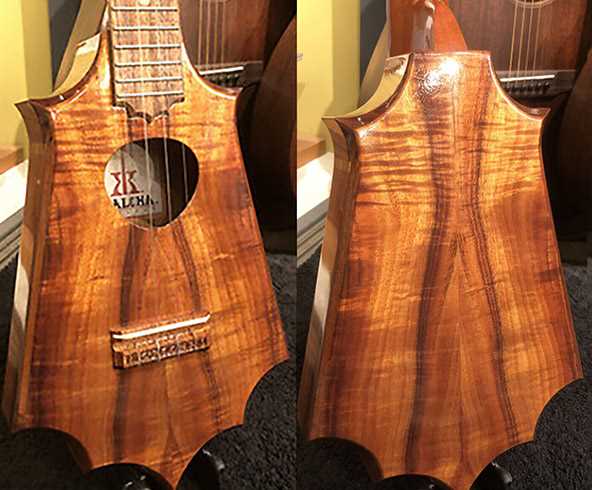
This custom bookmatched koa Hawaiian ukulele is selling for just under $3,000.
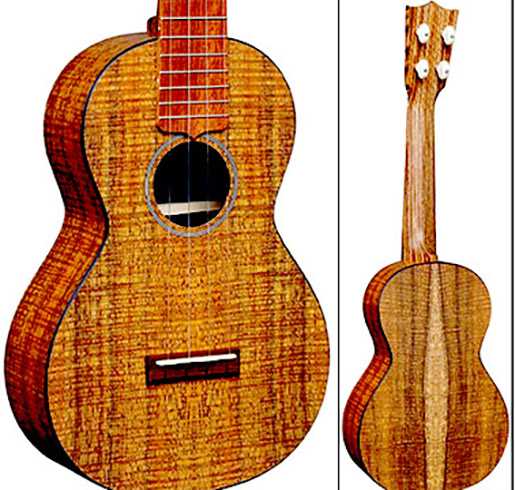
This factory-made ukulele is made of HPL made to look like koa and retails for $300.
Yes, I will admit that in my example the real wood uke I’ve shown does look better, but there is a deal. The deal is, the HPL uke doesn’t have a thin laminate of wood on top for show. That’s just a picture of koa wood! The top layer of paper has a picture of koa wood printed on the paper and if you look closely when you have the instrument in your hands you can see the dots in the photograph. Maybe that’s why it doesn’t appear more flamboyant, because every uke with that picture would look exactly the same.
Resistance to weather — An all-wood instrument should be stored at between 72 to 77 degrees F and keep the wood at 45 – 55 percent humidity, according to C.F. Martin & company. But in Hawaii, where some of the best guitars and ukes are made, the humidity seldom gets as low as 50 percent. So the instruments are stored carefully when not in use.
An HPL instrument can be stored in a hot car or taken to the beach and sit in a tent for days with no problem, because the resin in the material makes it highly resistant to moisture. It’s also far stronger than real wood, plus much lighter.
And an HPL instrument sounds as good or better than one made from koa — Each all-wood ukulele has a unique sound and that’s part of what you pay for when you spend so much money for a handmade instrument. Each HPL instrument sounds like all the others because the process makes them very uniform. And they sound as good as the best handmade instruments, though there will always be exceptions in the top tier of instruments.
Back to airguns
In 1947 the Sheridan company brought out their model A that we call the Supergrade today. It retailed for $56.50 at a time when a Winchester slide action model 61 rimfire (a very desirable firearm) sold for less than $50. The barrel in that Sheridan rifle was made from phosphor bronze. Why? Was it better? The two men who created the Model A rifle felt it was. They developed several test jigs to test certain things and they found they could get the highest velocity from a phosphor bronze barrel. In fact, when they switched to the Blue Streak and Silver Streak rifles that followed in 1949, they made those barrels from brass. It was better than steel but not as good as phosphor bronze. And these two softer materials are also easier to rifle — not a small concern when discussing production.
Isn’t steel the best barrel material?
Steel is a good material for rifle barrels. It’s tough and can withstand lots of shots with minimal wear. It resists the heat of combustion when gunpowder burns. But multi-pump airguns don’t burn powder.
Multi-pump airguns exhaust high-pressure air to push the pellet, and when high-pressure air decompresses rapidly, moisture droplets form. Steel rusts in the presence of moisture — phosphor bronze and brass don’t. Do you get it? The right materials may not always be the historically finest materials, but that’s because when looking at history you are considering something that isn’t exactly the same as the thing you are now contemplating. Said simply — airguns are not firearms.
A real-world example
I’m about to tread on some toes. I don’t mean to, but I can’t avoid it. The HW 75 single stroke pneumatic air pistol that was also formerly sold as the Beeman P2 is a delightfully accurate airgun with a wonderful trigger. It retails for about $500 and is made from real wood and metal.
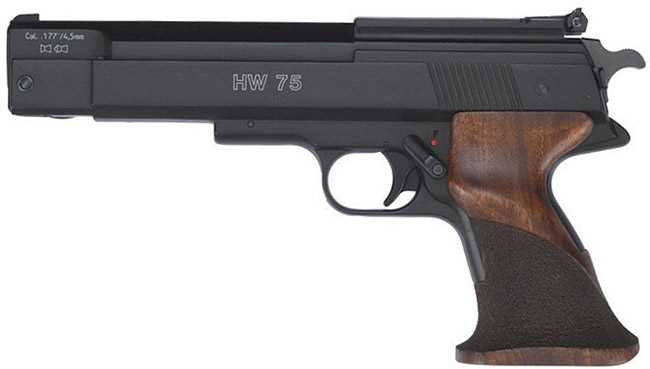
HW 75 single stroke pneumatic pistol.
But there is another single stroke that stirred the pot. When the Beeman P3 single stroke pneumatic pistol came out people hated it! They said it was plastic, because that’s mostly what you see on the outside. But the P3 is delightfully accurate and has a wonderful trigger. And it retails for just over half as much as the HW 75.
And then came the Beeman P17. It looks very much like a Beeman P3 and functions similarly, yet retails for less than one-sixth of what the P3 sells for.
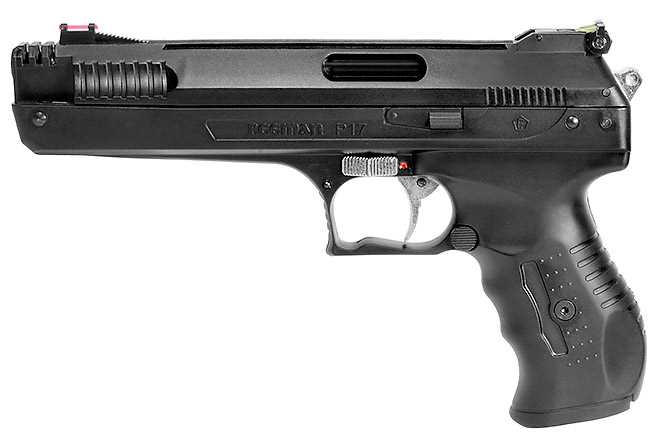
The Beeman P17 looks very similar to the P3.
In truth I have owned and tested all three airguns. The Beeman P2/HW 75 has a gorgeous trigger and feels great in my hand. It’s heavier than the Beeman P3/P17, so if weight is what you want, it’s the one for you. But the accuracy is fairly equivalent to that of the P3, perhaps slightly better, and the triggers are so close I can’t pick.
In truth the P17 isn’t quite as accurate as the P3, but it is still very accurate. Its trigger isn’t quite as nice as the P3’s, though it is very nice and can be made even better.
What I’m telling you is there is an ever-so-slight difference between the HW 75 and the P3 and there is a slightly larger difference between the P3 and the P17, but the P17 gives you no less than 90 percent of what the HW 75 has and the P3 gives about 96 percent.
Value
Which one do you buy? It’s subjective, isn’t it? One person values accuracy over everything else. Another values appearance. And another wants both. And still another wants the best deal possible. Three different airguns and four different ways of looking at them.
Modern materials
The automobiles of the 1940s and ’50s had steel bodies made from what today would be considered heavy metal stock. Today’s vehicles are made from thinner stuff — MUCH thinner stuff! But today’s cars get three times the mileage and possibly more, and their lighter weight is part of why that is true.
My digital caliper came from China and cost me $20. It measures in SAE (inch), metric and fractions of an inch. When I measure with it I get a number out to three or even four decimal places.
My Mitsutoyo dial caliper measures only inches and stops at the thousandth of an inch. It’s heavy and the caliper jaws move with a silky smoothness. It does not need a battery like the thinner and lighter Chinese digital caliper. And it cost many times what the Chinese caliper cost.
The Mitsutoyo is by far the “nicer” measuring instrument, but it isn’t any more accurate. And it is one-tenth as discriminating. Know why I own it? It doesn’t need batteries, plus its jaws open to the 8 inches I sometimes need. The Chinese caliper is the greatest value. The Japanese caliper is the more favored tool.
Summary
Today’s report is not written to change anyone’s mind. It’s written to get you to ponder the things you appreciate and wonder why you do.


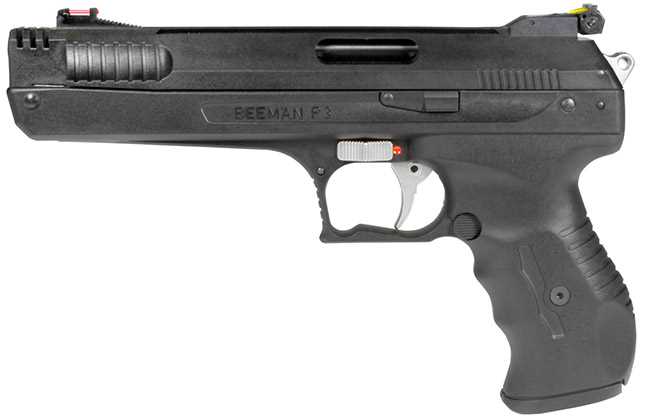
BB,
Although wood and metal appeals to the traditionalists. Metal and and plastic has it’s fans among those that grew up holding military firearms made since the 70s. I’ve read that there are hunters who have a knockabout stock made of synthetic material when they take their rifle out into the woods but after cleaning replace it with a finely figured walnut stock for display. I don’t think there is anyone who can argue that wooden stocks will swell if they are exposed to excessive moisture for a prolonged period of time which can affect accuracy.
Has there been any other gun other than the AR17 shotgun that utilized an aluminum barrel?
Siraniko
I think the Modoc had an aluminum barrel.
Rambler,
The Modoc has an aluminum barrel shroud. There is a rifled steel barrel inside.
BB
B.B.
You just convinced me to change all my springers from Moly to the new synthetic Krytox/Ultimox lubricants.
I bet you use synthetic engine oil in your HARLEY!
-Y
Yogi,
Yes, I do. Harley recommends synthetic oil because their engines run so hot.
BB
So do I.
Walnut stock treated with linseed oil and deep blue steel. Iconic gun construction.
I love it for the beauty of it, just that. Since we’re talking about guns we may have to consider that for centuries wood and steel were the only easily available stuff to make them cheap and in quantities. Synthetics came fairly lately but they cannot be surpassed from the technical point of view.
To each his own.
Have a great weekend.
BB
I’ll bet there would have been a lot more traditional ‘Plastic” airguns around if it existed in its current form back then. Not too many options available at the time. Wood was good.
Plastics have gone through a tremendous evolution making its use much more practical these days. Especially now that it’s mixed with other material as a composite for improved strength and durability.
When I opened the Crosman AK1 I had to tap on it to figure out what it was made of. The same with the MTR77 NP except it had assembly screw holes all over it. Now if they could just figure a better way to hide the seams.
The attention to detail today is outstanding but some companies have yet to maintain a uniform finish. It’s obviously plastic when the finish is shinny in some spots and flat in others… all over it.
Not that big of a deal when the airgun copies a firearm that actually utilizes composite plastic for the stock and forearm but has a metal receiver. Imitating or getting that Parkerized metal look with plastic is totally achievable now. Not to mention the look of real wood.
Composites are totally acceptable to me as long as the weight of the airgun is reasonably close to the firearm it resembles or should be if it is suppose to look like one..
This wood vs. synthetic thing is something like a gas grill vs. charcoal grill.
For me what really matters is the price – performance ratio at the end. Example: yesterday I received the Diana p-five springer pistol. I dismantled it, made the zero-check and proper lubrication. With collimator it makes lots of fun. It will be a “all duty” plinker for all occasion. It is not the most accurate pistol, it has no wood, but it cost me 69EUR and it is very fun to shoot. For the price it is top. But if I would buy some expensive match pistol, I would not stand finish like this, of course. The accuracy also would be a no go. But I can’t expect to have nice wood grip and perfect performance from a 69EUR pistol, can I?
What I would like to say is that this whole discussion wood – synthetic is become boring. It is like talking about the taste – some people really want to buy Fiat Multipla. They really do 🙂 Personally I like the classic wood metal and no f… true glue stuff on open sights. Even though I have two rifles with synthetic stock, and I like them like this. Let’s stay a bit open for something different.
About the barrel made of steel and moisture airgun issues: shooting the lead pellet will leave some lead surface inside the barrel and it does protect it. I saw so many old airguns after years in some humid basement, outside all rusty, just terrible. And the barrel inside as a new one First thing I do after buying a new airgun is the zero check, dismantle and proper lubrication. Then I shoot 500 pellets and after this sequence you can put it away for even a long time.
I have to agree with Tomek on the barrel rust. In the club I belong to we have five “club” guns. They are used by the members and by the newer kids in the middle and high school airgun teams. They each get tens of thousands of rounds through them every year,, and they have been here for the last twenty that I have been a member.
They were cleaned when they were first purchased and possibly once or twice in their long lives. We have three FWBs and a couple Anschutz. They remain exceptionally accurate and tho I have only used two of the FWBs,, but in the two I used the barrels looked perfect (no rust).
We keep them in a locked closet in our concrete block building. Of course they are regularly cleaned and oiled on the outside,, but much experience has proven that cleaning a barrel changes the shooting character of the rifle. Often as much as a thousand rounds are needed to “tighten things up” again.
Your mileage may vary,, but this has been the logic and practice of a club that has been producing winning air rifle and small bore titles for over 60 years.
Ed
Hi everybody,
finally, some new Ukulele content 🙂
When it comes to materials, for me it’s wood and metal all the way. First of all, I just like the look and feel, which is purely subjective. Also, plastics *can* have issues with ageing such as going brittle, getting sticky, etc.
Getting the HW75/P2 was really not a hard choice for me.
1. I really like the look and feel of the HW45
2. I really like wood and metal
3. I’m going to have this thing for a *long* time
4. They are a little cheaper in Germany compared to the USA
From all I hear about the HW40PCA, it’s a great airgun and great value. Probably a great choice for anyone looking for a very accurate target pistol that doesn’t break the bank.
As for the P17… As an adult, I’m not sure I really see the point. At least not in Germany, where it is half the price of the HW40PCA. The HW40 is fairly affordable and I like Weihrauch as a company. Why settle for the copy when I can get the original which is better?
BTW, the name of the caliper is “Mitutoyo” (no “s”. It confused me too, at first, and funnily enough, I have a Mitsubishi and a Toyota :-). I bought one a while ago and it’s a nice caliper (I don’t have another one to compare it to).
Stephan
I agree with CptKlotz : I too, distrust in the longevity of plastics !
Here’s the worst example I experienced:
My beloved plastic ice hockey scates (great fit, very comfortable, good control/confidence) turned into black chocolate overnight, ie very brittle. I remember the sudden sensation when the whole sole broke away, like hitting a bump, and then my sock on ice… 🙂
My Legends Cowboy Lever Action airgun has a convincingly and very nice wooden stock that is actually plastic. I like it’s looks, but how long will it last?
My ugly, wooden stocked ASP20 taught me that wood only looks good, when it’s brown… 🙂
As for the metal in most of my airguns, I absolutely hate having to apply rust prevention after every touch, grrr…
I have some very fine examples of air rifles made of steel and walnut. Because they are old and/or maybe not functioning properly, I was able to get some of them for almost nothing.
I have a laminate stock air rifle that I prize highly and is extremely accurate. It has a superb trigger. It also cost a lot of maney.
I have a plastic stock air rifle. It has a terrible trigger and is not that accurate. It was also very cheap. I acquired it as it can be upgraded. Yes, this will cost extra, but will still be relatively cheap.
I concern myself more with the internals in today’s airguns. How are they put together? Most, as cheaply as possible. You will pay for something that will last. Even “plastic” stocks. Some are very well made, and others are cheap. You usually get what you pay for.
B.B. perfect Friday blog. A controversial (but not political topic). Who knows where the discourse will go?
I have a Crosman 362 and my daughter’s Daisy 853S, both with synthetic stocks. Both are perfect for what they are. One is the epitome of a general use airgun, the other built for precision and accuracy. But I enjoy the feel of my 1971 Winchester 435 (Diana 35) and I love giving the steel and wood a nice rubdown with ballistol at the end of a shooting session. Makes the steel shine and the wood glow. I think she looks forward to it too and does her best.
BB,
As an old guy, it’s wood and steel for me. I’ll admit that plastic (sorry – synthetic) on guns has advantages and has come a long way since I first saw it on the Daisy BB guns. While it wins from the functional/minimal maintenance perspective it will never be as nice as wood.
That’s a real nice hunk of walnut – just looking at it makes me want to make something out of wood! Not surprised at the price. In my late teens I made a “wall hanger” stock for a friend’s father from a piece of french burl walnut that was beautifully figured. I almost passed out when (afterwards) I was told that he had payed $700 for the blank. Thats at a time when you could feed a family of four for $30 a week! At these days prices, $1,261 is a real deal by comparison.
Agree with Roamin… wiping down the gun after a session is part on the whole shooting thing. 🙂
Hank
Give me wood,
Give me steel,
That’s how I want my airgun
To feel.
Apologies for FM’s Fake Haiku annoyance, could not resist. Hard to resist a nice wood-and-steel Weihrauch as well. However, it is sometimes necessary to yield to practicality and availability of materials. For most, budget limits play a big part in deciding what is important in an airgun, though ole FM would think accuracy and a good shooting experience is the minimum one should aim for; as for plastics, at least we’ve moved on beyond Bakelite.
FM,
No need for apology. I like it.
I’m beginning to think it depends on the rifle. A rifle with beautiful mirror like bluing deserves a fine looking wood stock. Not so much on an AR-15.
Wood has the benefit of being user friendly in extremely cold conditions and I assume synthetics do as well for the military to accept it’s use. But then why does the AK-47 still use wood? Late to the game? I think the AK-74’s come in wood and brown or black synthetics now. Perhaps it’s just the way various countries choose to produce them.
Bob M,
Plastic is cheap. It is also easy to mass produce.
Many moons ago, I purchased a lot of 1906 Brazilian Mausers. Most of them had walnut stocks. The bayonets had walnut grips. I paid almost nothing for these rifles. These are worth a small fortune these days.
I have a 1906 BSA air rifle hanging over my fireplace. It has a walnut stock. Everything else is steel with the exception of the piston seal, which is leather. It would cost thousands to make this air rifle today. I picked it up for a little over one hundred dollars and fixed it up for almost nothing.
I wonder how long these plastic and pot metal things will last?
RR
Good to hear from you. Lets put ourselves on ice for a hundred years after we are dead and find out. I’ll leave my AR-15 A2 outside and you can leave any wood / steel rifle you want outside as well. Just hope the blog is still here 😉
Have a fine airgun day !
Don’t know what make ukulele he played, but he was definitely one-of-a-kind. It has not been determined whether or not he was a closet airgunner.
https://youtu.be/hCq5d0P0bEY
B.B.,
Great report! This brought back memories from the old days, my college days. When I was a freshman, back in 1981, everyone in the engineering curriculum had to take at least one course in Materials Science (Materials 101 =>).
On one of our tests, we had to do an analysis of several different materials, then pick the best one to make a piece that was part of the support structure of an automobile. I (and MANY others) crunched the numbers, and came up with a type of plastic as the best material. The second best material was a mild grade of steel. So, I figured, “I must have made a mistake; the plastic CAN’T be the right answer!” So I crossed that out, and selected steel.
Before the prof handed back the tests, he said, “C’mon guys! You are YOUNG! I’m old and set in my ways, but you guys are supposed to think outside the box…the plastic WAS the right answer! And most of you had that; but then you crossed it out, and switched to steel.” *shaking his head sadly*
LOL! Your report from today dredged that memory up right quick; the prof would have LOVED this report! 🙂
Blessings to you,
dave
For how long would that plastic last?
RidgeRunner, it was some type of pre-Clock era polymer; I believe it was supposed to last 30 years minimum.
Which is another reason for my bias against such materials; I’m driving a 1997 F150 that I expect to last me for the rest of my life. The small Feathercraft boat I just restored was built of aluminum in 1951…and she’s still in fantastic shape…I expect my materials to last a loooong time! Hahaha! 😉
I always wonder about ‘aircraft aluminum’ as the copywriters say. I mean is it the stuff they use to make the cup holders, or is it the stuff to make the whatchamacallit holding the wings to the fuselage. It makes a difference….
pacoinohio,
What is aircraft aluminum?
Even the wing spars and wing root box on the Airbus and Boeing sheep haulers is usually Carbon Fiber these days.
shootski
Shootski-
Re: Aircraft Aluminum- My point exactly. Would much prefer the boys in advertising at least attempt to give us the alloy and temper. It seems easy enough for the knife peddlers/manufacturers.
B.B. and radership,
I was reading about the old HW90 (Theoben design Gas Spring) being modified before Weihrauch did .25 caliber from the factory. A Buckingham, UK gunsmith, Steven Harper, bored out .22 caliber barrels and made CUSTOM .25 caliber rifled Brass tube to line the bore. He used a narrow 20 land technique to keep the friction at a minimum. Brass has a lower friction factor for Lead projectiles. I’ll bet those cost a pretty penny!
What got me to find that was studying up on Gas Spring SHORT (fast) Lock Times.
The why is to understand the WHY some magnum gas springs can shoot modern irgun bullets/slugs well. Short Lock times mean higher projectile RPM but barrel rifling design and perhaps materials/coatings are in play as well.
Not much information out there but we are in Early Days of the move away from Diabolo pellets for ALL Sporter airguns.
shootski
Shootski,
You go dude! Those ASP20s have really hooked you! LOL! You cannot stand it! You have to dig!
That Harper dude took what was probably the cream of the gas sproingers at the time and figured out how to make it better. It will be a Rutherford, Quakenbush, Barnes, Harper, etc. who will figure things out and some company like Weihrauch that will pick it up and run with it. It will not be cheap, but it will be right.
PS: Twist rate has a lot to do with RPM.
RidgeRunner,
The ASP20s have only a broadening effect on my interest in all things ballistics; the Cult of Nimrod and Mars have been the core drivers. After all I do NOT subscribe to the Molon Labe concept since Xerxes killed them and took what implements were left on the field of slaughtered Spartans.
I prefer the more successful approach of bringing implements to bear: Dam the torpedos FULL SPEED AHEAD!
https://www.usni.org/magazines/naval-history-magazine/2014/july/damn-torpedoes
Whatever Farragut ordered was better in my book than Molon Labe!
shootski
Shootski
After reading the article of the link I confess that I can’t get the connection in your thinking. It would be interesting for me to understand since I believe I have learned quite a lot about the whole concept of Molon Lave.
Bill,
Molon Labe. Literal translation is Come Take; that is either simply a suicidal taunt or a rather weak defensive bluff in my opinion. Unfortunately for the Spartans the Persian King Xerxes came and did exactly that to them. In the current usages by 2nd Amendment supporters it isn’t much of a rallying cry in my opinion given how quickly most have gone along with violations of an Original Bill of Rights Amendment in various States and communities.
On the other hand, even though Admiral Farragut’s battle plans took a bad turn for a time he regained the offensive without taunts or asking for a defeat but rather leading his force on to a victory.
I prefer his outcome.
shootski
HI see now the point regarding Admiral Farragut’s strategy. Regarding King Leonidas’ strategy and mentality that’s a whole other story.
First the sound choice of the battlefield. A narrow passage where a few thousands of trained warriors easily defeated their enemies because their opponents could not attack with their whole mass. The battle was lost when betrayal, usual in our history, came along. The thing is that King Leonidas released all his allies from their duty in order for them to retreat so they could fight another time. His ethics did not allow him to do that so he remained to set an example for the rest of Greece.
Now, why Alamo comes to my mind?
Second, regarding Molon Lave (not labe). It does mean come and take.
It was his reply when Xerxes asked them to surrender their arms, before the battle. He knew better…
I believe that you understand the difference between his actions from just suicidal behaviour. The one thing he could not handle was just ONE traitor.
Bill,
As far as the history you are spot on! I was going more along the lines of some gun rights folks taking Molon Labe (sic) and using it as a guiding principle. To me that is just a poor PR campaign slogan.
Both the sea battle/Land battle at the mouth of Mobile Bay and the Land battle at Kolonos Hill are familiar to me having visited both venues. I have kayaked the entrance to Mobile bay on tide changes and it is an interesting experience depending on the winds and tide velocity. The Greek location isn’t as it was at the time of the battle with some major Tera forming having been done in the intervening time. But it is still a formidable place to lay a battle plan.
Damn the torpedos, 4 Bells, 8 Bells, 16 Bells on the Telegraph!
shootski
Bravo, Vasili.
Shootski
Speaking of choosing a location for a battle, especially when being vastly outnumbered, I suggest you look up “Salamina” and then “Dardanellia”, since you are a navy man in your heart.
I believe you will see that there are some Admiral Farraguts in the Greek history. In case you want a brief presentation I would be more than happy to assist.
Shootski, I don’t understand your references to Cult of Nimrod and Mars in reference to gun control.
Just because the Spartans were outflanked due to treachery, doesn’t mean Xerxes was not defeated. To me, Molon Lave means that for the sake of freedom, you must never surrender, no matter the odds. In that context, I think Molon Lave is a fine motto against anti-gun extremists.
Wood can be anything from pallet wood dunked into a varnish bath, up to highest grade laminates or walnut stocks.
Plastic can be anything from blow formed PVC that will crack after losing its softeners, all the way up to high tech materials that will last for decades.
Yes, and those high tech plastics cost a lot also.
The question how long will the material last begs an answer. I had two pairs of high end ski boots bought 15 years apart both to either soften or crack after several years of good service. Both failures came at inopportune times. Wonder what is the lifespan is for carbon fiber resin power line towers and fishing rods.
Deck
Decksniper,
The composites are interesting and mostly follow the rule: you get what you pay for. It seems manufacturers have found the precursors are the place to spend the most money and then optimize the combination of the buildup and cure to get the desired functionality.
It has been a slow process over the past 35 years with a great many breakthroughs. If consumers don’t ask for the expected Service Life but just buy This Years graphics ski boots (Alpine & Nordic) will continue to fail at inopportune times for the few who really USE them for more than stylish status symbols around the lodge. I remember my leather 3 Pin boots that also “failed” at times that were horrifying! And, folks always said; You get what you pay for…most of the time!
I have seen the same in Sea Kayaks too.
shootski
Shootski
My first ski boots were some combination of leather and wool felt I think. Like my ice skates they were serious side to side ankle strainers.
Deck